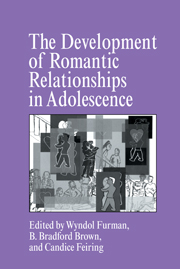Book contents
- Frontmatter
- Contents
- Contributors
- Foreword
- Acknowledgments
- 1 Missing the Love Boat: Why Researchers Have Shied Away from Adolescent Romance
- Part I Processes in Romantic Relationships
- Part II Individual Differences in Romantic Relationships
- Part III The Social Context of Romantic Relationships
- 10 Adolescent Romance and the Parent-Child Relationship: A Contextual Perspective
- 11 Romantic Relationships in Adolescence: The Role of Friends and Peers in Their Emergence and Development
- 12 “You're Going Out with Who?”: Peer Group Influences on Adolescent Romantic Relationships
- 13 The Cultured and Culturing Aspects of Romantic Experience in Adolescence
- 14 What's Love Got to Do with It? Adolescents' and Young Adults' Beliefs About Sexual and Romantic Relationships
- Part IV Conclusion
- Author Index
- Subject Index
12 - “You're Going Out with Who?”: Peer Group Influences on Adolescent Romantic Relationships
Published online by Cambridge University Press: 05 October 2014
- Frontmatter
- Contents
- Contributors
- Foreword
- Acknowledgments
- 1 Missing the Love Boat: Why Researchers Have Shied Away from Adolescent Romance
- Part I Processes in Romantic Relationships
- Part II Individual Differences in Romantic Relationships
- Part III The Social Context of Romantic Relationships
- 10 Adolescent Romance and the Parent-Child Relationship: A Contextual Perspective
- 11 Romantic Relationships in Adolescence: The Role of Friends and Peers in Their Emergence and Development
- 12 “You're Going Out with Who?”: Peer Group Influences on Adolescent Romantic Relationships
- 13 The Cultured and Culturing Aspects of Romantic Experience in Adolescence
- 14 What's Love Got to Do with It? Adolescents' and Young Adults' Beliefs About Sexual and Romantic Relationships
- Part IV Conclusion
- Author Index
- Subject Index
Summary
One of the hallmarks of American adolescence is the broadening and intensification of peer relationships (Brown, 1990; Hartup, 1993). During this life stage young people typically expand the time spent with peers, rely more on peers for advice and support, and work out their identities and aspirations within the context of peer relationships. The peer system itself expands, most notably with a new form of dyadic association: romantic relationships. To a limited extent, researchers have explored various facets of this new form of relationship: its connection to family structure and processes, its impact on the emotional and sexual lives of young people, its associations with participants' personal characteristics such as sex role orientation or attachment style, and its role in the social mandate of mate selection and marriage. Rarely, however, have researchers given concurrent attention to two other critical components of adolescent romantic relationships: the social context in which they are primarily embedded, that is, the social world of peers and the changes or metamorphosis that they manifest across adolescence. Both of these components are addressed in several other contributions to this volume, but they are the focal interests of this chapter.
- Type
- Chapter
- Information
- The Development of Romantic Relationships in Adolescence , pp. 291 - 329Publisher: Cambridge University PressPrint publication year: 1999
- 209
- Cited by



